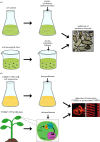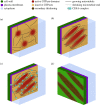Secondary cell wall patterning-connecting the dots, pits and helices
- PMID: 35506204
- PMCID: PMC9065968
- DOI: 10.1098/rsob.210208
Secondary cell wall patterning-connecting the dots, pits and helices
Abstract
All plant cells are encased in primary cell walls that determine plant morphology, but also protect the cells against the environment. Certain cells also produce a secondary wall that supports mechanically demanding processes, such as maintaining plant body stature and water transport inside plants. Both these walls are primarily composed of polysaccharides that are arranged in certain patterns to support cell functions. A key requisite for patterned cell walls is the arrangement of cortical microtubules that may direct the delivery of wall polymers and/or cell wall producing enzymes to certain plasma membrane locations. Microtubules also steer the synthesis of cellulose-the load-bearing structure in cell walls-at the plasma membrane. The organization and behaviour of the microtubule array are thus of fundamental importance to cell wall patterns. These aspects are controlled by the coordinated effort of small GTPases that probably coordinate a Turing's reaction-diffusion mechanism to drive microtubule patterns. Here, we give an overview on how wall patterns form in the water-transporting xylem vessels of plants. We discuss systems that have been used to dissect mechanisms that underpin the xylem wall patterns, emphasizing the VND6 and VND7 inducible systems, and outline challenges that lay ahead in this field.
Keywords: cell wall patterning; cellulose; microtubules; plant cell wall; xylem.
Conflict of interest statement
We declare we have no competing interests.
Figures




Similar articles
-
Spatial organization of xylem cell walls by ROP GTPases and microtubule-associated proteins.Curr Opin Plant Biol. 2013 Dec;16(6):743-8. doi: 10.1016/j.pbi.2013.10.010. Epub 2013 Nov 7. Curr Opin Plant Biol. 2013. PMID: 24210792 Review.
-
A Novel Plasma Membrane-Anchored Protein Regulates Xylem Cell-Wall Deposition through Microtubule-Dependent Lateral Inhibition of Rho GTPase Domains.Curr Biol. 2017 Aug 21;27(16):2522-2528.e4. doi: 10.1016/j.cub.2017.06.059. Epub 2017 Aug 10. Curr Biol. 2017. PMID: 28803875
-
CORTICAL MICROTUBULE DISORDERING1 Is Required for Secondary Cell Wall Patterning in Xylem Vessels.Plant Cell. 2017 Dec;29(12):3123-3139. doi: 10.1105/tpc.17.00663. Epub 2017 Nov 13. Plant Cell. 2017. PMID: 29133465 Free PMC article.
-
Two Complementary Mechanisms Underpin Cell Wall Patterning during Xylem Vessel Development.Plant Cell. 2017 Oct;29(10):2433-2449. doi: 10.1105/tpc.17.00309. Epub 2017 Sep 25. Plant Cell. 2017. PMID: 28947492 Free PMC article.
-
Secondary cell wall patterning during xylem differentiation.Curr Opin Plant Biol. 2012 Feb;15(1):38-44. doi: 10.1016/j.pbi.2011.10.005. Epub 2011 Nov 9. Curr Opin Plant Biol. 2012. PMID: 22078063 Review.
Cited by
-
Carbon Monoxide Alleviates Salt-Induced Oxidative Damage in Sorghum bicolor by Inducing the Expression of Proline Biosynthesis and Antioxidant Genes.Plants (Basel). 2024 Mar 10;13(6):782. doi: 10.3390/plants13060782. Plants (Basel). 2024. PMID: 38592836 Free PMC article.
-
Effects of fluorescent tags and activity status on the membrane localization of ROP GTPases.Plant Signal Behav. 2024 Dec 31;19(1):2306790. doi: 10.1080/15592324.2024.2306790. Epub 2024 Jan 25. Plant Signal Behav. 2024. PMID: 38270144 Free PMC article.
-
The Carbon Flow Shifts from Primary to Secondary Metabolism during Xylem Vessel Cell Differentiation in Arabidopsis thaliana.Plant Cell Physiol. 2023 Dec 21;64(12):1563-1575. doi: 10.1093/pcp/pcad130. Plant Cell Physiol. 2023. PMID: 37875012 Free PMC article.
-
Identification and expression analysis of the Xyloglucan transglycosylase/hydrolase (XTH) gene family under abiotic stress in oilseed (Brassica napus L.).BMC Plant Biol. 2024 May 15;24(1):400. doi: 10.1186/s12870-024-05121-5. BMC Plant Biol. 2024. PMID: 38745278 Free PMC article.
-
Confined-microtubule assembly shapes three-dimensional cell wall structures in xylem vessels.Nat Commun. 2023 Nov 13;14(1):6987. doi: 10.1038/s41467-023-42487-w. Nat Commun. 2023. PMID: 37957173 Free PMC article.
References
-
- Nishino T, Takano K, Nakamae K. 1995. Elastic modulus of the crystalline regions of cellulose polymorphs. J. Polym. Sci. B: Polym. Phys. 33, 1647-1651. (10.1002/polb.1995.090331110) - DOI
-
- Grujicic M, Zhao H. 1998. Optimization of 316 stainless steel/alumina functionally graded material for reduction of damage induced by thermal residual stresses. Mater. Sci. Eng.: A 252, 117-132. (10.1016/S0921-5093(98)00618-2) - DOI
Publication types
MeSH terms
Substances
LinkOut - more resources
Full Text Sources
Other Literature Sources

